It was the 6th of Karthik in the year 2067 by the Nepali calendar but despite the future-sounding date, I had been thrust back in time. I had come to the village of Puma, high in the Annapurna Himalayas, to experience a home stay in Nepal. Sitting cross-legged on a carpet rolled out over the chilled concrete porch of Aama Gurung’s mountain home, I sipped tea sweetened with milk from the buffalo, gazing out over the massive Himalayas, still shrouded in pre-dawn darkness.
Aama – literally mother in Nepali – shares her house with Nani, an older woman who has no remaining family. As usual, seventy-something Aama and the somewhat younger Nani had begun their chores before sunrise. Nani tossed fresh hay into the buffalo paddock, then dug through day-old fodder with her bare hands, bringing up mounds of fresh dung for use as fertilizer in the garden. Aama swept the porch and courtyard with a long whisk broom fashioned from sticks and straw, while Prakash, a 24-year old grandson stoked the morning cook fire in an outdoor clay oven. Sitting, enjoying my tea, I felt pampered and useless but they refused my repeated offers to help, explaining that in their culture, “Guest is god.”
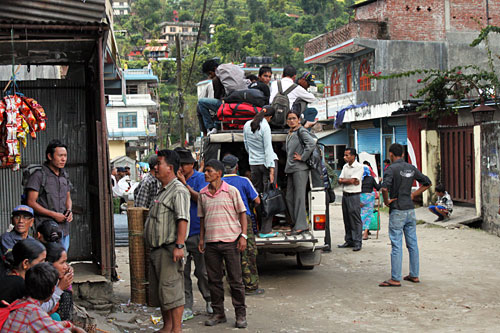
Life in the tiny mountain village is beautiful and simple, but it is not easy. Just getting to the village was exhausting. The previous day I took a bus from Pokhara to the end of the line in Besisahar, where I was met by Prakash, my guide and translator for the duration. My host, Giri Gurung of Nepal Tourism Travels, had explained we would take a 4-wheel drive jeep from Besisahar up to Puma. I foolishly assumed this would be a private jeep and so was surprised when Prakash led me to a street corner where dozens of people were waiting for public transport jeeps.
As the only means of access to these remote communities other than walking, seats were in demand; many people had been waiting since the previous day. Prakash harangued each driver that pulled up, trying in vain to get us seats. Three hours later I was still sitting with my back against the rattling tin wall of a shop with my feet stretched out into the dusty dirt street, having long since given up hope that we would reach Puma that day. Prakash, however, was not so easily discouraged. He continued to beg for a seat, offering to pay more than the 110 Rupee fare ($1.50 U.S.), and finally convinced one jeep owner to kick other passengers off to make room for us when he upped his offer to 250 Rupees.
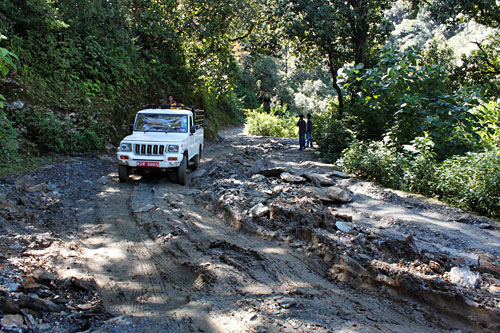
I climbed into the rear and plunked down on one of two facing wooden benches running down the sides of the extended cab, balancing my pack on my lap rather than relegating it to the rooftop and chancing damage to my electronic equipment. A long-legged man sitting across from me roughly shoved my legs apart and thrust one of his knees between mine, while the woman to my left poked her shoulder firmly into my breast. With my hiking boots taking up more than an equitable share of the precious little floor space that was not mounded with sacks of grain and boxes of cooking oil, we started uphill on a rock track gutted with twin trenches that masqueraded as a road.
Within minutes we were high above Besisahar, jouncing through 18” deep ruts and skirting giant boulders. Around a long curve the city disappeared, replaced with vistas of lush gold rice fields ready for harvest and newly-planted fields of grass-green millet, terraced down mountains rising in every direction. Half an hour into the trip, suffering from bruised knees and a sore throat brought on by cold evening temperatures, the jeep ground to a crunching halt, sunk to mid-wheel in ruts made muddy by recent rains. We climbed out while the driver expertly extracted the vehicle and then pretzeled ourselves back inside for more torture. One hour later I almost kissed Prakash when he told the driver to stop, turned to me and announced, “We are here.” Gingerly, I shook my half-asleep leg, handed down my backpack, and eased my aching hip and knee down to the road, wondering why I put myself through these things.
Can’t view the above slide show of the tiny village of Puma, Nepal? Click here.
I scrambled down the pebble-strewn path to Aama’s house, dumped my luggage in the guest house (a spacious room with five beds above the stable) and headed out to get acquainted with the family that would be my hosts during my five-day home stay in Nepal. For the next couple of hours, neighbors and extended family began to dribble into Aama’s compound as they do each night, since she is one of very few villagers who own a TV. But this evening, rather than march upstairs for their favorite program they sat on the porch with me, chattering in a stream of unintelligible Nepali interspersed with an occasional English phrase. Chija, already an incredible beauty at eleven years old, sang Row, Row, Row Your Boat for me to show off the English she is learning in her local government school. My attempt to teach her Itsy, Bitsy Spider, complete with hand signals, was met with gales of laughter when Prakash translated. Chija patiently taught me the Nepali words for touch, welcome, and others, most of which I promptly forgot, except for the really important ones: water is pani and toilet is char pee. They left me finally, drawn by the lure of TV, and I gratefully climbed beneath a thick comforter for a night of delicious, deep sleep in the cold mountain air.
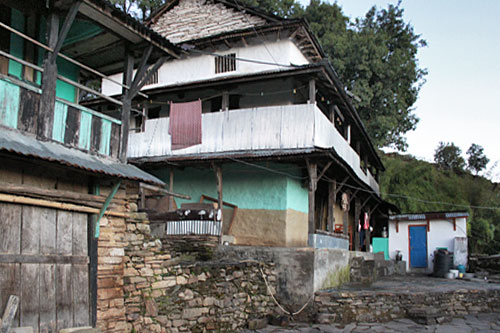
The next morning as I was enjoying my tea and the stunning views, Aama, bent over with age, slowly carried a platter full of gleaming silver urns to the low stone wall at the edge of the patio. Squatting down, she reverently rinsed the vessels, refilled them with water from the artesian well, and sprinkled fresh flower petals on top. Placing the first of these urns on the wall, she faced the sweeping valley and pressed her palms together at her heart, sprinkled water over the wall in a blessing, then repeated her prayers at various spots around the house. Devotions complete, she turned once again to her work, feeding her chickens and scrubbing out the squat toilet.

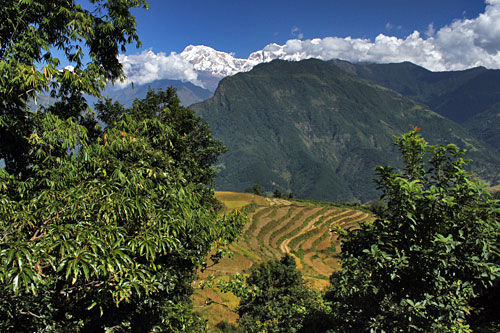
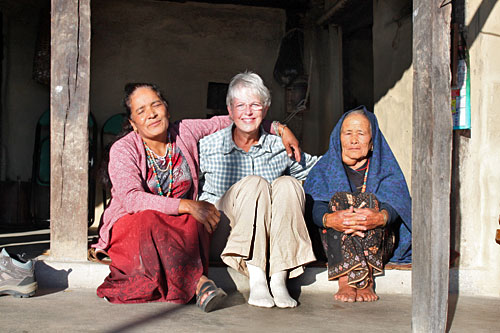
I was embarrassed. I have no chickens to feed or buffalo stalls to muck out. When I am hungry I usually go out to a restaurant or, in the rare instance when I cook, need only turn the dial of a stove. When I am dirty I have hot water at the touch of a knob rather than a metal dipper and a steel tub filled with ice-cold water. I don’t have to grow and harvest my own food or spend a day traveling over obscenely rough roads to purchase basic items. Though incredibly difficult, Aama’s life is filled with music, laughter, love of family, and gratitude. Compared to hers, my life is easy. Yet I cannot find ten minutes each day to meditate and give thanks for all I have, and I no longer had any doubt why my path led me to Puma.
Giri Gurung, managing director of Nepal Tourism Travels & Adventures, organized a portion of my home stay in Nepal, including my trips to Nagarkot, Changu Narayan, Chitwan National Park, and this amazing four-day home stay with his family in Puma. Nepal Tourism Travels & Adventures office is in Kathmandu, conveniently located in the Thamel backpacker district. Their website is www.nepaltourismtravels.com.np, and Giri’s email is [email protected] or [email protected].

Thanks to share best place pics with us.